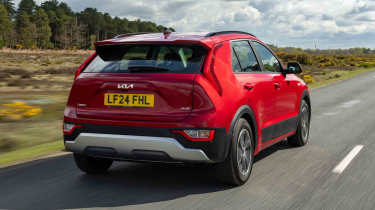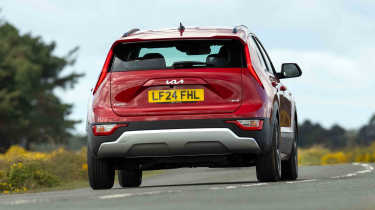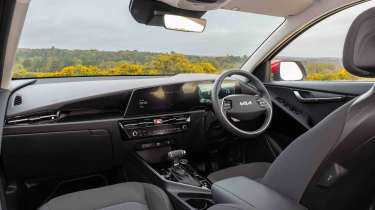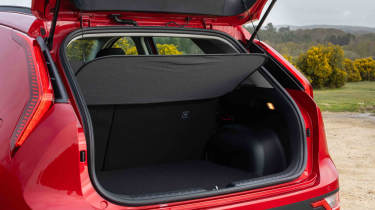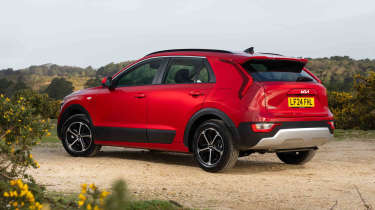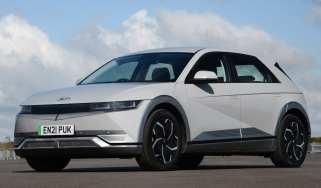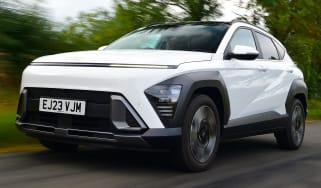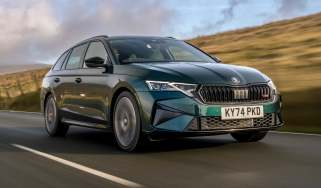Kia Niro review
Efficient, practical and boasting excellent on-board technology, the Kia Niro is a family SUV that offers great value for money

Is the Kia Niro a good car?
The Kia Niro once again delivers on the practicality front, and any notion that it would be compromised due to the mix of internal combustion and pure-electric powertrains can be dismissed. The conventional hybrid model is a tough competitor in a congested market, while the plug-in hybrid offers the flexibility of its electric power that is impressive as well as efficient. The range-topping Niro EV doesn’t offer a world-beating range, but its versatility, comfort and excellent onboard technology will appeal to family and business users alike.
Cabin space across the Niro range is superb, its infotainment system is top-notch, and the low running costs are particularly appealing, but just like the old car, the Niro doesn’t feel all that special to drive, and some of its interior quality is lacking. That aside, the Niro (in whichever form you choose) is a strong contender across a variety of segments, and one of the best small SUVs on the market right now.
| Key specs | |
| Fuel type | Hybrid, electric |
| Body style | Small SUV |
| Powertrain | 1.6-litre, 4cyl petrol plus 1x e-motor, front-wheel drive 1.6-litre, 4cyl petrol plus 1x e-motor, front-wheel drive, 11.1kWh battery |
| Safety | 4 star Euro NCAP (2022) |
| Warranty | 7yrs/100,000 miles |
How much does the Kia Niro cost?
Pricing for the entry-level Niro Hybrid in 2 trim starts from around £30,000, while the equivalent Niro EV comes in at over £37,000. The Niro PHEV starts between the two (although closer to the EV version) at around £35,500.
Kia launched the first-generation Niro in the UK back in 2016 and it was a smash hit. It managed to win plenty of Auto Express group tests against esteemed opposition and the all-electric e-Niro won our 2019 Affordable Electric Car of the Year award. This second-generation model looks to follow in the footsteps of the original, once again being offered with hybrid, plug-in hybrid and fully electrified variants (although the electric Niro is now called the Niro EV). It also managed to win our Small SUV of the Year award in 2022 and our sister title Carbuyer’s 2023 Car of the Year title shortly after it launched.
The Niro has received a major makeover for its second generation with an entirely new front-end design with pinched headlights and a single light cluster below (quite similar to BMW’s recent design language). The electric Niro EV gets a slightly different face due to the charging port being located at the front, rather than on the front wing of the Niro PHEV.
More reviews
Car group tests
- BYD Atto 3 vs Kia Niro EV 3: 2023 twin test review
- MG4 vs Kia Niro EV: 2022 twin test review
- Kia Niro vs Nissan Juke: 2022 twin test review
In-depth reviews
Long-term tests
Road tests
Used car tests
Like the old model, the Niro hybrid utilises a 1.6-litre GDi (Gasoline Direct Injection) petrol engine combined with an electric motor fed by a small battery, all used to drive the front wheels (like all Niros). The same petrol engine features in the plug-in hybrid, but it’s mated to a more powerful electric motor and larger battery for a pure-electric driving range of up to 40 miles. Both hybrids get a six-speed dual-clutch automatic transmission.
The 64.8kWh battery found in the Niro EV is barely any bigger than the old e-Niro’s unit, and its 201bhp power output is identical. But range is up an extra five miles to 285 miles, while its recharging time from 10 to 80 per cent takes 45 minutes, which is nine minutes quicker than the old e-Niro.
The Niro’s trim structure is incredibly simple, kicking off with the entry-level ‘2’, followed by mid-range ‘3’ and finally top-spec ‘4’. All models are equipped with alloy wheels, LED daytime running lights, a digital instrument panel, Apple CarPlay, Android Auto, a reversing camera, rear parking sensors and smart cruise control, among other safety features. The size of the digital driver’s display and central touchscreen vary depending on the trim level, with range-topping models equipped with two 10.25-inch panels.
Engines, performance & drive
The dynamics of the Kia Niro have been improved thanks mainly to the introduction of its K3 underpinnings. The platform is shared with Hyundai, and Kia’s parent company has claimed the architecture allows for better body control due to a lower centre of gravity. Whichever Niro you pick, it’ll feel much more stable and compliant in the bends than plenty of rivals.
In the corners, it’s fairly easy to reach the Niro’s limit, after which point you’ll find plenty of safe and manageable understeer. The steering is not particularly communicative, but it is accurate and has a reassuring weight, which inspires confidence through corners.
On top of this, the seats are surprisingly supportive, with plenty of side bolstering to keep you in place.
Due to the additional weight of its batteries, the Niro EV doesn’t feel quite as nimble as its hybrid sibling and is a bit more fidgety over ruts and bumps in the road. The hybrid feels more settled and allows for smooth progress on most roads, where there’s little difference in comfort between the lower spec 16-inch wheels and the 18-inch wheels that come as standard on top-spec 4 models. Wind noise and tyre roar are kept to a minimum, even at motorway speeds.
Two driving modes are available for the hybrids: ‘Eco’ and ‘Sport’. Credit to Kia, there’s a noticeable difference between the two on the move. In Eco mode, throttle response is slowed and gear changes happen earlier to provide more efficiency. In Sport, the throttle response is sharpened, and the Niro is keener to hold onto gears. Both have plenty of flexibility, however, so you don’t end up chopping between the two that often.
The Niro’s brakes don’t offer that much feel, and you have to press them quite hard to garner some stopping power at higher speeds. They work better at slower speeds around town and are easy to modulate for a smooth stop.
The six-speed dual-clutch automatic transmission in the hybrids can be a bit slow to change gear at times, and kicks down sharply if you floor the accelerator before sending the revs skyward, but it does a good job of providing seamless shifts the rest of the time. The manual override paddles in the PHEV are best left alone because they can be painfully slow to intervene. If you put your foot down in either hybrid, the engine noise can sound a bit gruff at first, but this dies down once up to cruising speed.
We wouldn’t go as far as to call the Niro fun. It’s still a small SUV designed for comfort and practicality over driving thrills, but it’s easy to develop confidence from behind the wheel. The Niro does well in tricking you into thinking it's a smaller car, and it’s easy to develop confidence from behind the wheel.
| Model | Power | 0-62mph | Top speed |
| Niro 1.6 HEV ‘2’ | 125bhp | 11.3 sec | 99mph |
| Niro 1.6 PHEV ‘2’ | 168bhp | 9.6 sec | 104mph |
| Niro EV | 198bhp | 7.8 sec | 103mph |
0-62mph acceleration and top speed
The Niro Hybrid comes with a 1.6-litre four-cylinder petrol engine mated to a 1.32kWh battery and one electric motor. When combined, they are good for 127bhp and 265Nm of torque. With power being sent to the front wheels only (as with all Niros), the Hybrid model manages the 0-62mph sprint in 11.3 seconds and goes on to a top speed of 99mph.
With less low-down power than the plug-in hybrid or electric Niros, the base hybrid isn’t as adept at swift overtakes or punchy acceleration when merging with motorway traffic, so it’s at its best when it’s not being hustled and you’re just pottering around town.
The Niro PHEV features the same petrol engine, except it comes with an 11.1kWh battery. The plug-in hybrid produces 168bhp and 265Nm of torque, which gives it a 0-62mph time of 9.6 seconds and a top speed of 104mph.
The fastest Niro by far is the EV, thanks to its 201bhp electric motor, which can propel from 0-62mph in 7.8 seconds and reach a 103mph top speed.
MPG, CO2 and running costs
With prices for the entry-level Niro Hybrid currently starting at just under £30,000, not only does it sit in the same price range as the Hyundai Kona Hybrid and other small SUVs, but hybrid-only hatchbacks like the Toyota Corolla and Honda Civic, too.
Kia has embraced electrification with quite some gusto, and like its predecessor, the Niro is available with the full gamut of electrified powertrains – full-hybrid, plug-in hybrid and pure-electric.
Kia says the base hybrid can return up to 64.2mpg on a combined cycle – about five miles-per-gallon better than the old model – but we averaged 50.5mpg after covering more than 11,000 in our Niro Hybrid long-term test car. That’s still decent for a car that you don’t plug in, and we spent a lot of our time travelling on motorways where the engine is on most of the time. For comparison, the 11th-gen Civic we lived with only managed to achieve 45.1mpg after close to 6,000 miles of motoring. The Niro’s CO2 emissions are better, with the Mk2 Niro Hybrid emitting 100-106g/km, depending on which trim level you choose.
The Niro PHEV is more expensive to buy, but it’s also greener – emitting 18g/km of CO2, according to Kia – and can even achieve up to 353.1mpg on the WLTP combined test cycle. Figures like that sound very impressive, but you’ll need to charge the car regularly and drive on battery power as often as possible if you want to see close to those returns.
| Model | MPG | CO2 | Insurance group |
| Niro 1.6 HEV ‘2’ | 64.2mpg | 100g/km | 20 |
| Niro 1.6 PHEV ‘2’ | 353.1mpg | 18g/km | 23 |
Electric range, battery and charging
The plug-in hybrid Niro uses a 11.1kWh battery and offers a pure-electric driving range of up to 40 miles – or 38 miles if you upgrade to 3 or 4 spec with larger wheels. We expect closer to 30 miles is more achievable in day-to-day, so long as you charge the car regularly. Using a regular home wallbox charger, it’ll take around three hours to fully charge.
The Niro EV features a 64.8kWh battery that offers a maximum range of 285 miles – five miles further than the older Kia e-Niro could cover – but at least it’s competitive within the small electric SUV class. The Niro EV has also proved itself to be pretty efficient, with the ‘3’ version returning 3.9 miler per kWh in our twin test against the MG4, which equates to a real-world range of 253 miles. The top-of-the-range ‘4’ trim has the option of a more energy efficient heat pump (for £900), which might be worthwhile going for if you plan on tackling long trips in the winter.
A 10 to 80 per cent top-up from most rapid chargers takes at least 45 miles, while fully replenishing the Niro EV’s battery using a 7.2kW home wallbox will take about nine and a half hours.
| Model | Battery size | Range | Insurance group |
| Niro EV | 64.8kWh | 285 miles | 28 |
Tax
The low CO2 emissions of the Niro PHEV make it more appealing to company car drivers than the regular hybrid, but it can’t hold a candle to the Kia Niro EV in this department. Because it doesn’t produce any tailpipe emissions, the Niro EV sits in the lowest possible Benefit-in-Kind (BiK) company car tax band, and benefits from free road tax (VED) and avoids the London Congestion Charge, at least until 2025.
Insurance groups
The cheapest Niro to insure is the regular hybrid model, sitting in groups 20 to 21. The plug-in hybrid sits in groups 23 to 24 and the Niro EV is in group 28 to 29. Whichever powertrain you choose, the insurance rating rises one group for the 3 and 4 trim levels over the base 2 spec.
Depreciation
Data from our car market experts indicates that the Niro family should hold onto around 46-54 per cent of their original list price after three years and 36,000 miles of ownership, with the electric performing the worst, and the regular hybrid performing the best.
To get an accurate valuation for a specific model, check out our valuation tool...
Interior, design and technology
Kia’s bold new design language has transformed the Niro from a rather bland, innocuous SUV into one of the best looking family cars you can buy right now.
The second-generation Niro has a cleaner look to the front end with a set of distinctive angular LED daytime running lights paired with a thin chrome strip above the slim grille. Meanwhile, the Niro’s rear end is more squared-off and features boomerang-style vertical headlights.
The C-pillars actually sit away from the bodywork, funnelling air along the side to improve aerodynamic efficiency, according to Kia. Contrasting C-pillars are available on certain models, too, along with more vibrant paint colours, should you wish to make your Niro stand out a bit more.
What is the Kia Niro like inside?
Inside, we see a step up from the old model in terms of design and technology, but not so much in terms of build quality. The overall layout gives the cabin a bright and airy feel though it’s not quite as stunning as the cabin of the Mazda CX-30.
What is the interior quality like?
The Niro’s materials and buttons do feel robust on the whole, if not premium to the touch. The centre console is finished in piano black which is just waiting to be scratched, we fear.
Upgrade to the top-spec 4 models and some of the interior surfaces become a little softer and generally look more expensive, but we still wouldn’t call the cabin’s quality segment-leading. Top-of-the-range cars also come with an openable sunroof.
Sat-nav, stereo and infotainment
The entry-level ‘2’ in hybrid or plug-in hybrid guise comes with an eight-inch touchscreen with Apple CarPlay and Android Auto compatibility. Just like the old Niro, this grows to a 10.25-inch screen in the ‘3’ and ‘4’ with built-in sat-nav. The top spec ‘4’ models also get a head-up display and a 10.25-inch digital dash.
The digital dash itself is clear and easy to read, but instead of using a dial format for the rev counter or speedo it only offers a numbered readout. The 10.25-inch central screen is also crisp in its resolution, and the infotainment system is a doddle to navigate. Only when you quickly jump between menus can it start to lag slightly.
Beneath the screen, you’ll find a band of touchscreen buttons which can either control the cabin’s climate, or at the flick of a button, provide a shortcut menu to the infotainment screen. While we’d prefer physical knobs on the move, the touchpads are responsive and large enough to easily use while driving.
As standard on the Niro, you’ll find two front USB charge ports (one Type-A, one Type-C) and two Type-C charging ports on the side of the front seats. Top-spec 4 trim adds a sunroof and powered memory seats as standard, too.
Practicality, comfort and boot space
Given the K3 platform of the Kia Niro has to provide accommodation for hybrid, plug-in hybrid and full EV powertrains, the packaging employed to create space in the cabin is impressive.
There are some clever storage solutions dotted about the Niro’s cabin, too. For instance, the front cubby can be used as either general storage space or, at the touch of a couple of buttons, a pair of cup-holders reveal themselves. There’s more storage under the central armrest, and the glovebox is a decent size, but we found the door bins are very slim, which limits how much stuff you can store in them and means they’re off-limits for larger items.
| Dimensions | |
| Length | 4,420mm |
| Width | 1,825mm |
| Height | 1,585mm |
| Number of seats | 5 |
| Boot space | 451-1,445 litres (HEV), 348-1,342 litres (PHEV), 475-1,392 litres (EV) |
Dimensions and size
The latest Niro is taller, wider and longer than its predecessor at 1,585mm tall, 1,825mm wide, and 4,420mm long. It’s still classed as a compact SUV and is roughly the same size as Toyota’s C-HR and the Skoda Karoq.
Leg room, head room & passenger space
Cabin space was a real plus point of the old Niro, and it’s even better here thanks to the extra length, longer wheelbase and a slimmer front seat design that’s liberated more space for back-seat occupants, among other changes. Even sitting behind a driver over six-feet tall, rear passengers should have plenty of legroom. Headroom is also excellent due to the square crossover proportions of the Niro.
Up front, the low centre console, low window line and decent headroom combine to make the Niro feel spacious and airy inside. Meanwhile, rear passengers will appreciate the USB-C sockets built into the sides of the front seats so they won’t have to fight over who gets to charge their devices.
Boot
Boot space varies for each powertrain. The most spacious is the Kia Niro EV, which has an impressive 475 litres – that’s 53 litres more than the latest Vauxhall Astra – and does not even include the 20-litre storage space under the bonnet. Fold the rear seats down, and the luggage capacity expands to 1,392 litres.
The Hybrid comes next with a respectable 451 litres while, unfortunately, due to the battery being located at the rear, the Niro PHEV’s boot space falls to 348 litres. Folding the Niro’s 60:40 split rear bench gives you 1,445 and 1,342 litres to play with in the hybrid and plug-in hybrid, respectively.
The Niro does have quite a high load lip, which isn’t great when you’re loading heavier items, but the boot opening is nice and wide. We also like the lightweight load cover, which can be twisted and collapsed into a compact disc that you can stow pretty much anywhere.
Towing
The maximum braked trailer weight for the Niro hybrid and PHEV models is 1,300kg, while the EV is only rated to tow up to 750kg.
Reliability and safety
Based on the owners’ feedback from the 2024 Driver Power owner satisfaction survey, the Kia brand secured third place out of 32 in the best car manufacturer rankings.
The second-generation Niro was crash tested by industry experts Euro NCAP in 2022 and received a four-star (out of five) rating for cars without the safety pack, and five stars (which includes all Niros sold in the UK) for models that come with the more advanced autonomous braking system that recognises pedestrians and cyclists. The Niro’s 91 and 84 per cent scores for adult and child occupant protection are about average for this class, as is the 79 per cent score for safety assistance technology you get in all models sold here.
Speaking of which, the Niro comes as standard with a decent array of safety kit onboard, including a reversing camera, rear parking sensors, smart cruise control with stop/go functionality, hill-start assistance, lane keep assist and forward collision avoidance assist. Pricier models add front parking sensors, Highway Driving Assist, Blind Spot Collision Avoidance Assist and even a remote parking assist system.
| Key standard safety features | Euro NCAP safety ratings |
|
Warranty
As with all Kias, the Niro gets a seven-year/100,000-mile warranty. The warranty is also passed on to each owner, within the time or mileage limit.
Servicing
Service intervals for each iteration of Niro are every 12 months or 10,000 miles, whichever comes sooner.
Kia also offers a service plan package called ‘Kia Care’. It’s a fixed-price service package, which can be tailored to suit the age and mileage of your Niro.
Kia Niro alternatives
Given the Niro is offered with three distinct powertrains, it has a long list of rivals. The Niro Hybrid and PHEV come up against the likes of the Honda HR-V, Renault Captur, Nissan Juke, Toyota C-HR and this Kia’s sister car, the Hyundai Kona: our Car of the Year and Small SUV of the Year for 2023. The Niro Hybrid competes with the usual cohort of hatchbacks, such as the hybrid-only Toyota Corolla and Honda Civic, plus the Vauxhall Astra and Peugeot 308, both of which are offered with plug-in hybrid power.
The pure-electric Niro EV has a slightly different field of competitors, namely other small electric SUVs such as the Hyundai Kona Electric, BYD Atto 3, Peugeot E-2008 and Smart #1, not to mention zero-emissions hatchbacks like the Renault Megane E-Tech, Cupra Born, Volkswagen ID.3 and MG4.
Frequently Asked Questions
The Kia Niro is efficient, practical, striking to look at, and features excellent on-board tech, making it one of the best small SUVs you can buy right now.


